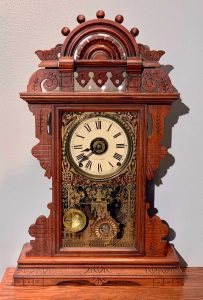Owning an antique clock

Antique clocks and watches are much more interesting and rewarding than modern clocks. Some of that charm comes with a bit of maintenance. Here are some important things to know.
Winding
All mechanical clocks get their energy from somewhere – usually a spring unwinding or a weight falling. Some clocks need winding every day – they are called 30 hour clocks. Most clocks last for 8 days and need to be wound once a week. Pick a day of the week where you will regularly be at home so clock winding can be part of your regular routine. I wind clocks on Sunday evenings as I’m nearly always home, and it feels like a natural part of getting ready for the upcoming week.
Different clocks wind differently. Most time and strike clocks wind inward – the winding arbor on the left side of the dial is for the strike and winds clockwise and the winding arbor on the right side of the dial is for the time train and winds counter-clockwise. Most clocks take about 14 half-turns of the key to be fully wound up after running for a week. Go ahead and wind the springs until they start requiring significantly more force to turn, then the clock is fully wound.
Every clock has its personality. Some clocks wind outward; on some clocks both arbors wind in the same direction. Most clocks can be wound until you feel resistance however be careful with some weight-driven clocks where care is needed to not wind too forcefully at the end or you can cause the weight cord to jump off the pulley, potentially causing the weight to fall!
Setting
Most antique clocks are set by moving the hands. Because the clock mechanism is complicated, you need to do this carefully. For clocks that are time only – that is they do not chime or strike – they only tell the time, you can wind the clock both forward and backward without risk of damage. For clocks with chiming or striking mechanisms you need to be more careful, as the strike mechanism can be damaged by wrong hand movement.
Chiming or striking movements can be set forward as much as you need to provided you let the chime or strike sequence complete before you move the hand further. For example, if the clock currently reads 10:50 but you need to set it to 11:35, you would move the minute hand around past the 12 and let the clock fully chime 11 times for the hour before moving the hand further, then move the hand to about 20 minutes past the hour to allow the 1/4 hour chime to sound (if your clock has one), then move the minute hand to 35 past the hour, which will cause the clock to chime the 1/2 hour strike or chime (if equipped).
If your clock showing time ahead of where it should be, you may in some cases be able to turn the hands backward, but you need to be mindful of the chiming and/or striking mechanism. Generally speaking it is OK to move the hands back slightly if the minute hand is in the first quarter of the hour (between 12 and 3) or the third quarter of the hour (between 6 and 9). These periods generally will be after the chime mechanisms have run their course, and small corrections are acceptable. Do not move the minute hand backwards if it is in the second quarter (between 3 and 6) or the fourth quarter (between 9 and 12) as you will likely encounter the chiming mechanism which can be damaged.
Timekeeping
Mechanical clocks are pretty amazing devices. A seconds pendulum clock – large clocks where each tick and tock of the pendulum takes 1 second – tick 86,400 times per day, which translates to 604,800 ticks per week. Mechanical clocks typically run about 99.95% accurate or better (within 1-2 minutes per week). This is amazing considering that the typical antique clock is over 100 years old and made using simple materials and methods. As impressive as that is, mechanical clocks aren’t as accurate as we are accustomed to with our satellite-synchronized cell phone and computer clocks, so we need to periodically correct their timekeeping.
Clocks keep time based on the length of the pendulum. Turning the rate screw to lengthen the pendulum causes the clock to run slower, and turning the rate screw to shorten the pendulum causes the clock to run faster. This is periodically necessary, as temperature and humidity changes affect the rate of a clock.
Clocks with metal pendulum rods are most sensitive to temperature changes. When the temperature rises, the pendulum rod expands (lengthens), and the clock runs slower. When the temperature falls the pendulum shrinks and the clock runs faster. Clocks with wooden pendulum rods are most sensitive to humidity changes. When humidity increases the wood expands and the clock runs slower. When humidity decreases the pendulum shrinks and the clock runs faster.
My rule of thumb is if a spring-driven clock is within 2 minutes per week I will just adjust the hands and not adjust the pendulum. If the clock starts gaining or losing more than 2 minutes per week I will start adjusting the pendulum a bit. Pendulum changes tend to happen in the spring and fall when seasons change. Weight-driven clocks are more accurate than spring-driven clocks, so I will adjust the pendulum of a weight driven clock if it gains or loses more than 1 minute per week.